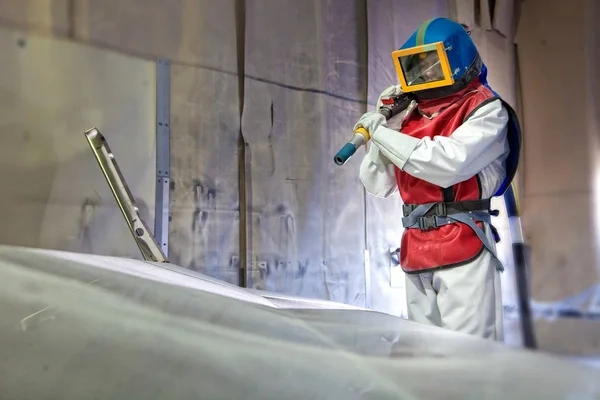Introduction
Surface preparation is a critical step in many industrial processes. Whether it's for painting, coating, or finishing, achieving a flawless surface is paramount. Sandblasting has long been the go-to method for efficient and precise surface treatment, but not all abrasives deliver the same level of perfection. White fused alumina, a highly refined abrasive, is fast becoming the top choice for industries seeking both power and precision. Its unique properties make it indispensable for achieving smooth, impeccable surfaces across a range of materials.
What is White Fused Alumina?
White fused alumina is a synthetic abrasive derived from the fusion of high-purity aluminum oxide at extremely high temperatures. The process produces a material that is crystalline, incredibly hard, and pure. White fused alumina boasts a Mohs hardness of 9, second only to diamond, which makes it particularly effective for cutting, grinding, and abrading tough surfaces. Unlike many other abrasives, it is free of contaminants and provides a consistent performance, making it an ideal choice for precision sandblasting.
How White Fused Alumina Enhances Sandblasting
Sandblasting is more than just surface cleaning; it's about creating a substrate that's ready for further treatment. White fused alumina, with its sharp, angular grains, excels at this. Each particle cuts deeply into surfaces, removing impurities, coatings, or oxidation with unmatched efficiency. The abrasive's hardness ensures that it doesn't break down easily, which means it maintains its cutting ability throughout the process. The result is a uniformly prepared surface that is free of imperfections and ready for coatings or other finishing processes to adhere more effectively.
Applications in Various Industries
White fused alumina is versatile, making it suitable for use in a wide array of industries. In the aerospace sector, where surface integrity is critical, it is used to prepare parts for painting or bonding. In the automotive industry, it ensures metal parts are free of rust and paint, providing a clean slate for repainting or coating. The electronics industry relies on it for cleaning delicate components without introducing contaminants. No matter the industry, white fused alumina's precision and reliability make it a favored choice for sandblasting.
Benefits of Using White Fused Alumina for Sandblasting
The benefits of white fused alumina in sandblasting are numerous. First, its extreme hardness means faster, more efficient surface treatment. Because it cuts deeper than many other abrasives, it reduces the time required for the sandblasting process. Additionally, its high purity ensures that no unwanted residues or contaminants are left behind, a crucial factor when preparing surfaces for subsequent treatments. Furthermore, its recyclability allows it to be reused multiple times, making it a cost-effective and environmentally friendly option.
Achieving Flawless Surface Preparation
Flawless surfaces are the hallmark of excellent surface preparation, and white fused alumina makes this goal attainable. The uniform, consistent particles of this abrasive produce a smooth and even surface, whether on metal, glass, or ceramics. With fewer imperfections, surfaces are better suited for coatings, which in turn increases their durability and resistance to wear. The sharp edges of each particle ensure that even the smallest impurities are eradicated, leaving nothing behind to compromise the quality of the final product.
Choosing the Right Grit Size
The success of sandblasting with white fused alumina often hinges on selecting the correct grit size. Coarser grits are typically used for aggressive material removal, such as stripping old paint or rust from large surfaces. Finer grits, on the other hand, are perfect for achieving a smooth finish on delicate parts. By choosing the appropriate grit size for each project, operators can maximize both efficiency and surface quality. The versatility of white fused alumina means that it is available in a broad range of grit sizes, providing flexibility for any application.
Environmental Impact and Sustainability
In today's industrial landscape, environmental considerations are more important than ever. White fused alumina, being free of harmful substances, offers a greener alternative to many traditional abrasives. Its recyclability further enhances its eco-friendly credentials. Unlike abrasives that break down quickly and must be discarded after use, white fused alumina retains its effectiveness over multiple cycles, reducing waste and lowering costs. As a non-toxic, non-reactive material, it minimizes the risk of environmental contamination, making it a sustainable choice for conscientious industries.
Safety and Handling Considerations
Although white fused alumina is a safer abrasive compared to silica sand, proper handling and safety precautions remain essential. Operators should wear protective gear such as respirators and goggles to prevent inhaling fine particles or dust. Additionally, working in well-ventilated environments and employing dust collection systems can minimize airborne particles, ensuring a safe and clean workspace. By adhering to recommended safety practices, operators can maximize the benefits of white fused alumina while maintaining a safe working environment.
Conclusion
White fused alumina is revolutionizing sandblasting, offering an exceptional combination of hardness, purity, and precision. Its ability to deliver flawless surface preparation across a range of industries makes it a valuable asset for those seeking efficiency and superior results. From industrial cleaning to delicate surface etching, this abrasive material has proven itself indispensable. As industries continue to demand higher-quality finishes and faster processes, white fused alumina stands ready to meet and exceed those expectations.
